I have once again returned to an Assassin’s Creed game and found great things. Specifically, I have learned a lot about open-world video games, how Ubisoft makes them, and why I love them so much. I must show you.
I’ve gone back to Assassin’s Creed Rogue, the underhyped last-gen release that was overshadowed by the heavily advertised Assassin’s Creed Unity. I’d already played it for 15 hours and finished its story many months ago. No matter. I’ve now played it 20 more hours on my PS3.
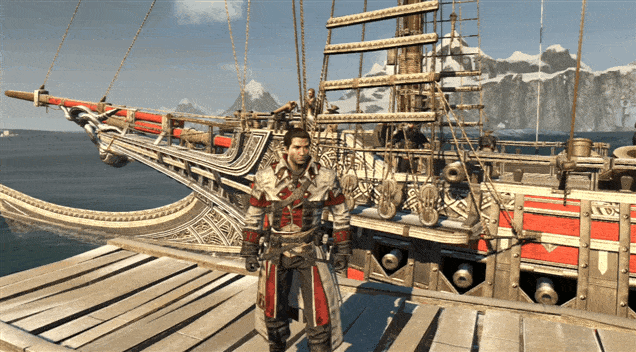
I know that you might be tired of Assassin’s Creed. It does feel like there is always a new one coming out. I agree with those of you who feel a series break might be needed, but I am also, paradoxically, hooked by nearly every new Assassin’s Creed release. I don’t just enjoy playing (most of) them, but, in recent years, I’ve had a grand time going back.
I think I’m weak for open worlds, particularly the beautiful ones that have been created for the more rural recent Assassin’s Creed games.
I’m also hooked, I’ve realised, by a style of design that I enjoyed so much in Super Mario 64. In that game, Nintendo’s top game designers sprinkled coins throughout unusually-shaped 3D worlds, using those coins as breadcrumbs to cajole us to explore nooks and crannies we would have otherwise missed. There have been a dearth of successors to the great 3D platformers of the Nintendo 64 era, but recent Assassin’s Creeds have proven to be unlikely candidates for the crown. Exploring their worlds does not require much skill, but time and again, I’ve found, the designers of these games have placed their collectibles on the game’s map in such a way as to pull players into hand-crafted corners that most players will never see.
I am also a sucker, I admit, to the trappings of Assassin’s Creed, particularly the mix of metropolitan stealth and grand naval adventure that Ubisoft’s development studios have crafted with Assassin’s Creed III, IV and Rogue. I love a good rooftop chase and I crave a big ship battle. I also actually like the modern day narrative and, well, I care about the prophesy of Juno. You don’t???
Let me show you some of my wonderful discoveries. Let’s start with beauty. Let’s start with Assassin’s Creed Rogue as a nature tour.
I climbed perches to admire a flock of seagulls:
I ran up a waterfall:
I found a remote island where the sky dumped snow and clapped thunder, seemingly by design:
If you only have eyes for PS4-level graphics, you may not be impressed. You may be immune to beauty and generally unable to feel. That is too bad. Seriously, though, as I play through the open world cities of Batman Arkham Knight (I’m just a few hours in) or Watch Dogs before it, I despair at the limited visual panache of their terrain. I enjoy open-world games that have memorable locations and that districts that look distinct. I like traipsing across the Martian landscape in Red Faction Guerilla or driving down a coastal highway in Grand Theft Auto San Andreas. In an open world game with as much open space as Assassin’s Creed Rogue, we can move from glaciers to forests to remote island cemeteries.
What a sight to find a shipwreck in the cold north, running past penguins and leaping from one boat’s mast to another:
What a joy it is to sail to an island to discover a settlement built next to a beached ship and a red barn, a settlement waiting for me to drop in (and kill people):
Much of what I enjoyed about Assassin’s Creed Rogue was its excess, an abundance of what we might derisively think of as content for content’s sake. The game is spread across three massive regions: a large map of 18th century New York; an enormous North Atlantic zone meant to be sailed through but also filled with settlements, shipwrecks and caves to explore on foot; and an even more richly-populated river valley, also built for a mix of sailing and land exploration.
To finish AC Rogue, you need to explore almost none of this. You can skip most of the towns and islands. You can sail very few of the game’s channels. You can ignore the game’s assassination missions, barely upgrade your boat and leave all but a tiny fraction of the game alone. You certainly don’t need to sail to the north of one of its maps just to pick up a single collectible. If you do, though, you will discover that some Ubisoft artists and designers laid out a small climbing challenge for you:
I like those lonely-feeling discoveries in video games. I like feeling like I’ve found a corner of the game that few others have seen. Perhaps this would make a Ubisoft game developer sad. What must it be like, after all, to craft a corner of an open-world game that you know players may never visit. This, though, is what many Ubisoft developers sign up for. The company’s CEO Yves Guillemot has repeatedly promoted open-world game design, and he has arranged his global company and its armies of developers to make enormous virtual worlds in which to set video games.
Lord knows why games like Far Cry 4 or The Crew have to be as hilariously large as they are, but it seems that the scale of these games and the recent ACs must be due to the relative ease with which game designers draw square mile after square mile of interactive terrain. It is harder, no doubt, to fill that terrain with fun game missions. That is where the enormous AC Unity and, to an extent, Watch Dogs, struggled. You might expect Rogue to have similar problems. Its landmass is one of the most under-used in any recent big-budget video game, but is also some of the best laid. It at least benefitted from having designers who knew how to drop the right breadcrumbs to coax us into hiking through so many wonderful locales.
Here, for example, is an entirely missable piece of terrain I climbed through in the game’s remote Fort Blanc:
And here you’ll see a great cave I discovered simply because I just had to pick up a treasure chest that showed up on my map, tricky as it was to track down:
Some of the game’s best use of space involves its river valley map, where its designers figure out how to funnel the player through what starts to feel like scripted linear missions that are set in an open world. Again, they do this by drawing a collectible somewhere on your map and daring you to get it. You’ll see in this next video how I take the bait and wind up on a road that features a series of lightly-scripted challenges:
Assassin’s Creed Rogue was supposed to be an inversion of the series. You play as a Templar, an enemy of the Assassins. In the game’s main missions, this plays out well and to strong emotional effect as you cross paths with assassins you met and/or controlled in previous AC games. You feel the inversion less when exploring the game’s terrain, but it does manifest itself in some fun ways. You are, for example, always being hunted, which leads to moments like this when assassins prey upon you as you run through New York City:
You can also activate special defence missions where you have to race against time to stop five, six or seven assassins from taking out a target. These are fun, if a bit easy, and are set to a dramatic piece of music:
The game’s numerous animal-hunting missions are less fun, its supply raids at least challenging. Neither feel any different than what you might do as an Assassin:
What should a massive video game save for its most dedicated players? What should game designers create that they know the fewest possible players will experience?
One answer to that question: alternate outfits. They’re about as useful as those hundred or so extra lives that Super Mario 64 gave players only once they’d found its final star. In Rogue, you get them so late that they’re hardly worth the bother of equipping them. I guess you could try to just get all the Viking sword fragments so that you could look like a Viking sometime before the 31st hour you’re playing the game. I didn’t, because it doesn’t really work any other way. You’re finding this stuff only if you exhaustively explore.
The problem is that, as soon as you find the Viking armour, you’re going to have found just about enough stuff to find the Templar outfit, which I got just minutes later:
Of course, I found the native armour, too. And check out this practically Banjo-Kazooie-style forest I found it in. I had so much fun climbing through this place!
Bonus outfits are mostly useless, so how about final bonus missions? If you do all the assassination-defence missions in Rogue, you trigger a final one back in New York. Here’s how that goes down:
You’ll barely be able to survive the game’s three major naval clashes if you’ve merely finished the story missions. I got trounced when I was but a 15-hour veteran. If you steadily upgradeyour ship, though, they will eventually be a breeze. Here I am tearing through one of Rogue‘s epic naval encounters, me against a fleet of ships, many of which were on fire and heading straight toward me:
AC IV had similarly uber naval battles, but Rogue out-ubers that game with an ultimate naval fight. I tried to tackle that near the end of my epic play-through and was quickly demolished:
And then I tried a dozen or so more times, slept on it, tried again:
I got elite Kraken sails for my trouble.
After that, I thought I was done. I’d cleared the game’s maps. Then I remembered the game’s modern gameplay section, its first-person exploration of Abstergo Entertainment, the fictional video game company that purportedly made AC Rogue.
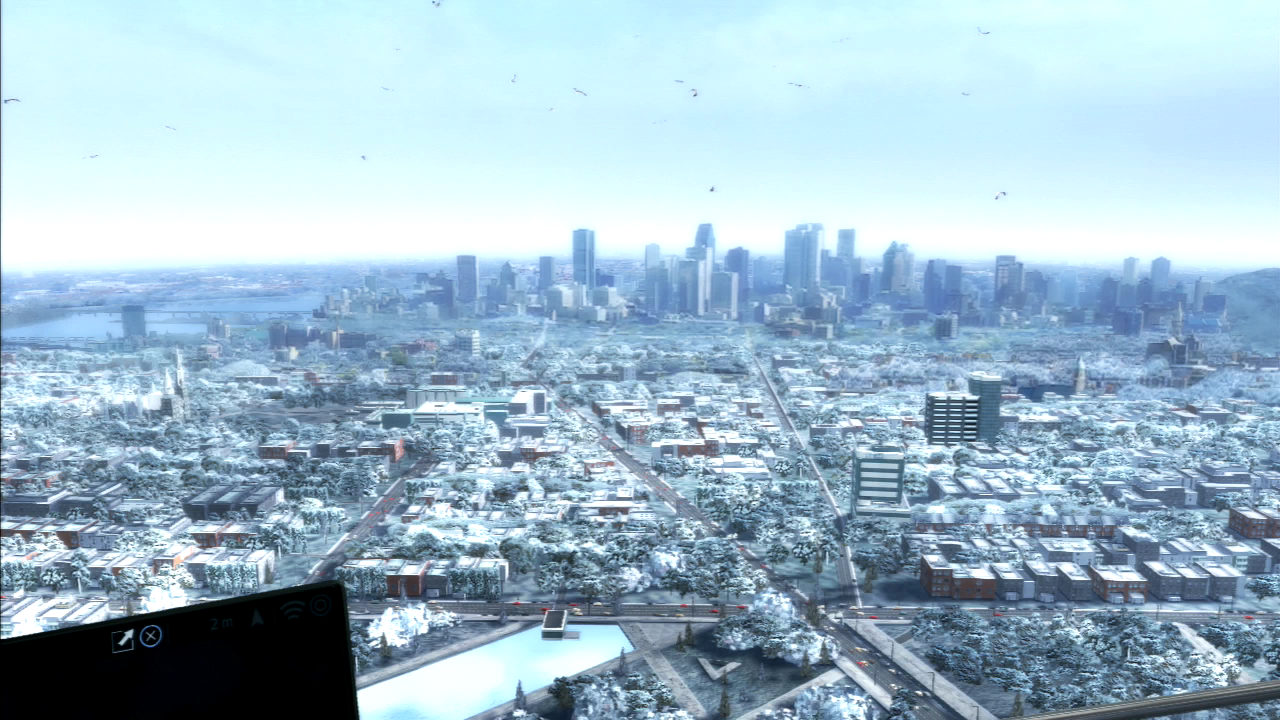
This is the corner of the game in which you nestle yourself only if you’re into this series to a nearly diagnosable degree. I am, so in I went. I mean, can you believe what I found out about Shaun Hastings (after completing a cool hacking mini-game)? You remember who Shaun is, I assume.
I have reached some 36 hours with Assassin’s Creed Rogue. I’ve treated it as a vacuuming chore and a nature hike. I’ve had the greatest time, mostly thanks to Ubisoft’s own weird obsessions of handcrafting worlds that are too large for its designers to fill with compelling gameplay.
I see commercials for Assassin’s Creed games every year and I see Ubisoft try to package Assassin’s Creed as this badass fantasy. I hit a moment like this in AC Rogue, and I think this is what they want to sell:
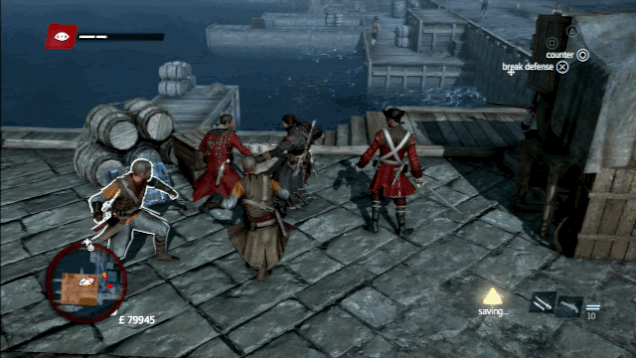
I will, however, continue to delight in exploring Assassin’s Creed worlds, looking for beautiful sights that only the designers and a small number of other gamers will see. The above GIF is what they sell, but this, is what I now play these games to see:
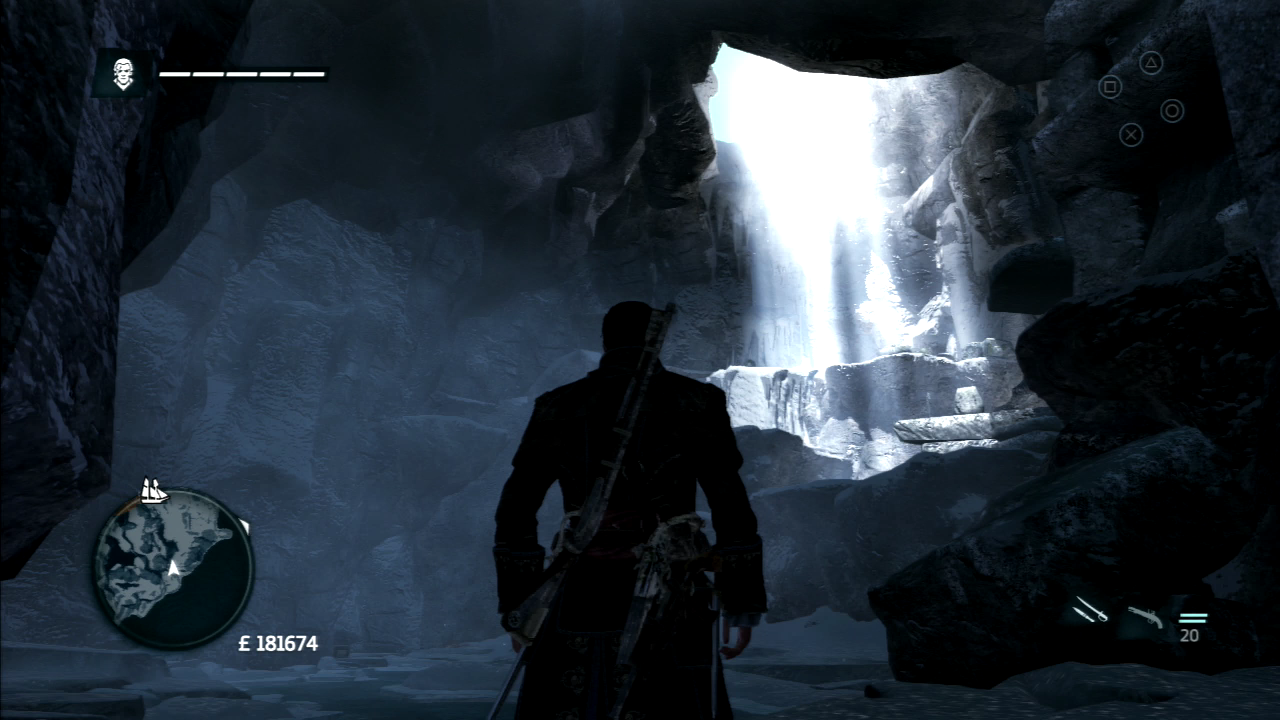
To contact the author of this post, write to stephentotilo@kotaku.com or find him on Twitter @stephentotilo.
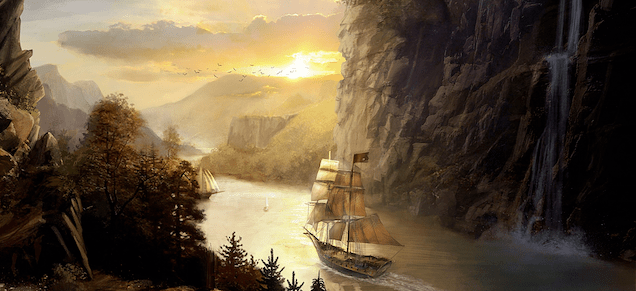
Comments
16 responses to “An Illustrated Guide To Why I Can’t Stop Playing Assassin’s Creed”
I played all the AC games, sans Rogue and feel like the problem with the world Ubisoft create is that it feels like a cookie cutter approach. When I’m climbing a tree, it feels like I’m climbing a re skinned version of another object.
The games felt very ‘modular’ if that makes sense and something about it didn’t feel quite organic. The fact that Ubisoft padded it out with copy/paste repetitive side stuff didn’t help with this either.
I think it has to do with the way in which the (granted) slick movements have to be implemented in order to look so slick and consistent with the surfaces you’re moving on. You climb a tree and you feel the character is locked onto it before you can climb it, in a similar way in which you climb ladders in fps games. When this goes wrong you run into walls or off buildings, because you always run and move on invisible rails, in AC games. Sometimes this feels very badly hidden and I feel like I’m playing something like Heavy Rain, if that makes sense. Other times the illusion of freedom is grand, though.
I get the article, I get that people may enjoy details and lovingly crafted environments. Yes, I found Florence really impressive.
Yet I can hardly say how much I despise the whole series and its continuous pumping out of yet another game in which major kills are just “push button for scripted scene”. Each time I tried, I really wanted to like AC games, but I always get to the point where suddenly I find it overwhelmingly boring. I think I’ve played 3-4 AC games and if the highlight for me is Naval Battles in Black Flag, then it’s just not worth it to keep trying to like them.
Yes, I’m currently going through Black Flag again ad quickly find it’s becoming my favourite in the series! Also, love the mention of Red Faction: Guerilla, that was a fantastic game imo!
ive played them all up to Assassins Creed 3. (im sucked into 100% completion) and i wont let myself start Black Flag yet. i really really really loved all the Ezio based AC games, that dude is the Sh&t. i like Connor too, but i definitely got sick of grinding, which was my demise. and since, ive been playing other stuff like GTA V.
i will get to Black Flag, just when things calm down elsewhere.
Rogue does interest me a lot, i dont care for Unity, or Syndicate (at the moment)
Connor was one of the most boring and flat protagonists in any game I’ve ever played. He felt so one-dimensional that it put me off the entire story. The other characters felt more dynamic.
Edward Kenway on the other hand was fun to play as.
i definitely understand and agree with what you say about Connor, but, i still found it believable and acceptable for him to be the way he was, and i think it fit the story. i definitely like Ezio because of his personality. im still yet to meet Mr Kenway.
I think Connor had the same problem as Lightning from Final Fantasy: his personality wasn’t as ‘in your face’ as your typical ‘hero’-type character. He wasn’t dashing, he wasn’t devil-may-care, he wasn’t making quips as he sliced the templars limb from limb. In short, he wasn’t Edward Kenway or Ezio Auditore, He wasn’t Nathan Drake and he wasn’t Dante. He was more like Adam Jensen or Snake, and even Altair. I guess that people just preferred the sassiness of Ezio, which is why Ubi went back to the likes of Edward Kenway, Shay, Arno and now the Frye twins. Connor turned out to be a little to ‘earnest’ to be likeable.
Black Flag easily the best Ass Creed game yet. Loved it!
hehe…………………….Ass…………………
hehe…………….. Loved…………………….
hehe………………. easily……………
hehe…………… best……………
Guide to why I don’t play Assassins Creed games anymore.
AA, aa, Aa, aA. Despite looking slightly different they’re still the same old thing.
Black Flag was ok
It’s kind of refreshing to see a positive article about AC. I like the franchise a lot (granted I’m only up to the start of 3) but it is one of the biggest non FPS franchises in the world for a reason.
I play them a few years after release – I played through the exio trilogy last year and have been planning to jump into 3 then black flag this year. 12 months after release you can easily find copies of these games for $20 – I found a collectors Ed. Rogue for $36 a month ago, which I promptly picked up.
You’ve given me that itch Stephen, I may have to jump back in to AC again.
Grabbed Black Flag in Games with Gold – and loving it. Having played 1 & 2 to death it’s nice to come back to the series a little further on. and find it’s comfortable platform is still there – but with a whole lot more going on.
Bought 2 and Brotherhood today, and I can’t wait to dive (or should I say eagle dive?) into them again, especially considering I bought the DLC for 2 when PSN had that discount of them some time ago.